New caps imposed on high-risk home loans

In a move to shore up financial stability, the Australian Prudential Regulation Authority (APRA) has introduced a new cap on high-debt-to-income (DTI) lending to curb what it sees as riskier borrowing practices.
From February 1, 2026, banks and other lenders will be limited to issuing no more than 20 per cent of new loans at six times a borrower’s income or higher, with separate caps for owner-occupiers and investors.
Domain chief of research and economics Dr Nicola Powell said the new cap does not ban high-DTI loans outright, but will create a mechanism that automatically slows high-risk lending if it accelerates.
“If the market heats up and high-DTI loans surge as they have in past cycles, the limit will start to constrain activity,” she said.
According to APRA, high-DTI lending remains well below the new 20 per cent cap. Recent data shows that about 10 per cent of new investor loans and less than 5 per cent of overall new lending are written at six times income or higher.
APRA chair John Lonsdale said that activating the DTI limit before high debt and credit growth become entrenched will minimise housing-related vulnerabilities.
“At this point, the signs of a build-up in risks are chiefly concentrated in high-DTI lending, especially to investors,” he said. “By activating a DTI limit now, APRA aims to pre-emptively contain risks building up from this type of lending and strengthen banking and household sector resilience.”
Powell said the new limit is a guardrail for stability, not a handbrake on demand.
“It reins in the riskiest edge of lending without punishing households, protects resilience without dampening construction, and gives APRA flexibility to tighten further if needed,” she said.
The new rule is less about denying access to credit and more about imposing a structural “speed limit” on high-leverage borrowing as the housing market heats up – a preventive measure to keep risk under control.
“It won’t cool prices or improve affordability – nor is it meant to,” Powell said. “But it does strengthen the system at a time when confidence is rising and lending appetites are shifting.”
We recommend
We thought you might like
States
Capital Cities
Capital Cities - Rentals
Popular Areas
Allhomes
More










